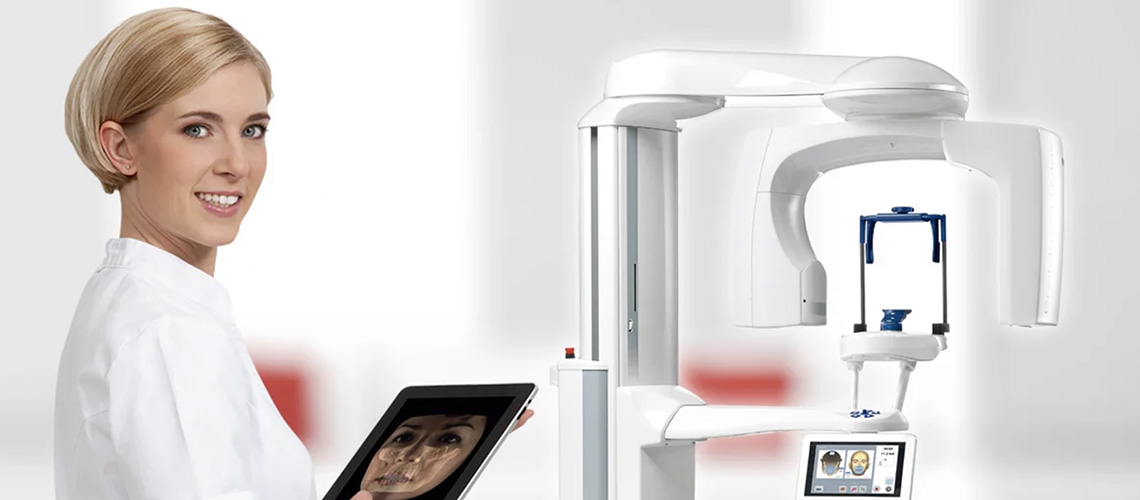
This leaflet aims to answer your questions about having a dental cone beam computerized tomography (CT) scan.
It explains the benefits, risks and alternatives, as well as what you can expect when you come to Fresher Breath Houghton. If you have any further questions, please speak to your Fresher Breath dentist or assistant, caring for you.
What is dental cone beam CT scan?
A dental cone beam (CB) CT scanner uses x-rays and computer information to produce 3D images of the jaws, teeth and/or skull. It is a smaller, faster and safer version of the regular CT scanner. Through the use of a cone shaped x-ray beam, the radiation dosage is lower, and the time needed for scanning is reduced. The machine moves around your head in a circular motion in a similar way to the panoramic dental radiography unit which is commonly used in dental surgeries and hospitals, which you may have already experienced.
What happens during dental cone beam CT (CBCT)?
You will be positioned in front of the CBCT machine. Your head will be carefully positioned and you will be asked to keep absolutely still while the scan is taken. We will ask you not to swallow, talk or move your jaw during the exposure. The positioning takes a few minutes, but each scan takes less than a minute to perform. You may need more than one scan depending on the reason for your examination. The whole procedure should not take more than 15 minutes.
Why should I have a dental CBCT?
The scan will give us extremely detailed 3D information which cannot be obtained from normal x-ray examinations. For example, if you are being considered for dental implants or other special procedures (bone augmentation, fracture stabilization), it enables us to assess the exact shape, density and position of the bone. For difficult root canal procedures, it can help us dissect the tooth/teeth in 3 Dimensions, to accurately and expertly perform the best work possible.
What are the risks?
CBCT scans are low-dose examinations and give an x-ray dose to the patient that is normally considerably less than a medical CT scan. A CBCT scan of the jaws would be comparable to approximately 6 to 21 days of normal background radiation (acquired from the sun). A CBCT scan of the jaws will give approximately one fifth to one tenth of the dose of a conventional CT scan of the same area. As with any x-ray examination, please inform the radiographer if you might be pregnant.
Are there any alternatives?
Yes – medical CT is the alternative, but this delivers a greater radiation dose. Another alternative is not to undergo the x-ray examination at all, but without this examination it may not be possible using traditional dental x-ray pictures to assess the bone accurately enough to allow your treatment to be performed safely.
How can I prepare for dental CBCT?
Before your CBCT you will be asked to remove glasses, dentures, hearing aids, earrings, tongue and nose studs, necklaces, hair clips and any other metal accessories that may affect the scan.
This is not an examination that requires any injections or special preparations. Our CBCT machine is top of the Range and therefore allows us to offer the ‘Proface photographic scanning’ feature – This is performed in the CBCT machine with the lights dimmed in the room. The machine gives off flashing lights during this special type of scan. You will be asked to stand very still and keep your eyes open during this photographic scan. This part of the examination does not use x-rays. This is an additional procedure that can be added above and beyond your needed scan, it will only be performed should you agree to it. It provides us with a 3D image of your face, so we can assess the position of the soft tissue structures such as your nose, chin, brow bone and ears.
Consent
We want to involve you in decisions about your care and treatment. If you decide to go ahead with a CBCT, you will be asked to sign a consent form. This states that you agree to have the treatment and you understand what it involves, including all risks and relevant information. If you would like more information about our consent process, please speak to a member of staff caring for you.
Will I feel any pain?
This procedure is 100% painless, but you will need to remain still for the duration of the scan. If you are claustrophobic please mention this to the radiographer so that they can offer you appropriate support and advice.
What happens after I have had the CBCT scan?
After the examination, the dentist will decide if he/she wishes to continue with the relevant treatment immediately, continue with other necessary treatment, send you for more investigative scans or send you home with a follow up appointment date. The professional who took your scan will write a report from the scan, and it will be sent through to the dentist who has referred you to us for the examination.
What do I need to do after I go home?
No special aftercare is necessary, you will be able to eat, drink and carry on all your normal activities.
What should I do if I have a problem?
In the unlikely event that you experience any problems following this examination, you can contact the department (details at the end of this leaflet). Outside these hours if you are worried you should go to your nearest Emergency Department.
Will I have a follow-up appointment?
As mentioned previously, follow up appointments, scans or investigations are subject to the referring Doctor’s wishes, so you may or may not require a follow up.